Sadamisaki Wind Power Project (Ikata Town, Sadamisaki Peninsula, Ehime Prefecture)DREAM Wind Sadamisaki

The Sadamisaki Wind Power Station is located on the narrow Sadamisaki Peninsula at the westernmost tip of Ehime Prefecture. With the Seto Inland Sea to the north and the Uwa Sea to the south, a group of giant wind turbines harness natural winds to generate clean energy.

1. To the Windmill Town of Sadamisaki
Sadamisaki is one of the windiest areas in Japan, with an average annual wind speed of 8.3 m/s. This strong wind, locally known as "maji," was a major obstacle to agriculture. Therefore, Seto Town (now merged with Ikata Town) formulated the Seto Town New Energy Vision in 2000 to utilize the strong winds and promote community development centered on wind power.
We developed a picturesque villa area (23.9 ha) overlooking the Seto Inland Sea and Uwa Sea at Sadamisaki, and with part of it serving as a wind power station, it contributes to the town's goal of becoming a "windmill town" while also being an excellent business plan.
2. Construction Plan with Minimal Environmental Impact
The theme during construction was to consider the surrounding environment as much as possible. The first consideration was to plan to minimize tree cutting at the wind power installation sites and along the transportation routes for the large blades and towers. The second was to bury all the power lines underground, which transmit electricity generated by the wind turbines to the base. This approach significantly reduces tree cutting compared to the conventional method of erecting towers and running power lines overhead, and it also avoids the risk of trees falling and breaking power lines during typhoons. Additionally, by creating a "windmill town" with no overhead power lines, it contributes to the beauty of the landscape.
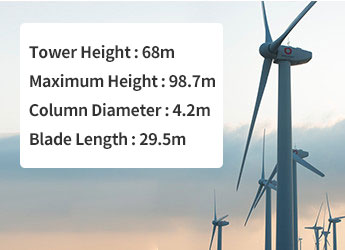
Size of Wind Turbine

3. Generates Electricity for Approximately 6,500 Households per Year*1
Unlike solar power generation , wind power generation can generate electricity even at night when the wind is blowing. Normally, the capacity factor*2 of wind power is said to be 20~30%, but in Sadamisaki, where the wind is strong, the capacity factor is as high as 38.6%. The wind power station at Sadamisaki has been in operation since 2006, and consists of a total of 9 wind turbines with a capacity of 1MW, generating electricity for approximately 6,500 households*1 annually.
*1 Calculated from the average amount of electricity generated since operation
*2 Capacity factor: The ratio of the amount of electricity actually generated to the amount of electricity continuously operated at rated output

4. Forward-Looking Inspection and Management
Regular inspections of the wind turbines are conducted at the Sadamisaki Wind Power Station. Inspectors climb a ladder 60 meters tall inside the tower for over five minutes and work inside the swaying nacelle.
Spare parts are always stocked to enable immediate response in case of malfunctions. This is because parts delivery can take four months to a year, so foresight in inspection and early ordering of parts if necessary is essential to prevent stock from running out.
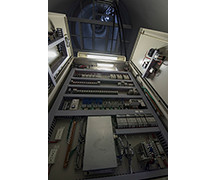
Inside the Tower

Inside the Nacelle

Power Generation Meter
The lower interior of the tower houses equipment such as substations, with each wind turbine functioning as a power station.
The wind turbines are equipped with anemometers and wind vanes; if the wind speed exceeds 25 m/s, the blades automatically change direction to shed wind and stop rotation, and the turbines automatically rotate to face the wind to maximize equipment utilization.
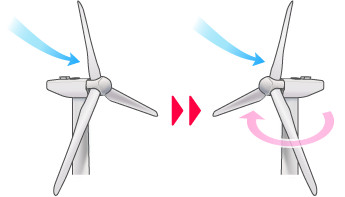
The turbines automatically rotate to face the wind head-on.

What is more dangerous to wind turbines than rain or wind is lightning. Since these wind turbines that stand at nearly 100 m tall are installed on mountains and prone to lightning strikes, receptors that divert lightning to the ground are attached to the blade tips, and these are thoroughly inspected.
5. Community Engagement (Windmill Festival)
The Windmill Festival is an annual event bustling with people, where participants can learn about wind power in a fun way. At this festival, our Group, including Daiwa Energy, along with companies operating wind power projects at Sadamisaki and local high school students, exhibit and communicate about wind power to the community while enjoying local specialty sales and fairs.

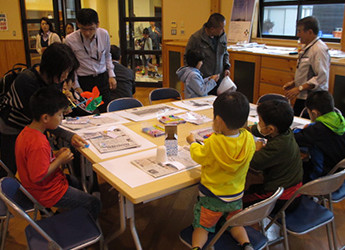
6. Net Zero Energy (Power Consumption Less Than or Equal To Generation by Renewable Energy)
Our Group aims to generate about 260 GWh, about double the amount of electricity we use, by 2020, through renewable energy projects under the theme: Effective Use of Wind, Sun, and Water. The DREAM* Wind project is part of this initiative, where our Group handles everything from construction to operation and management.
*DREAM stands for the Daiwa House Group, Renewable, Energy, Asset, and Management.

Voices of the Persons in Charge
At Daiwa Energy, we are actively working on power generation projects (wind and solar power) with renewable energy in line with the Daiwa House Group's Environmental Action Plan, "Endless Green Program." The power generation exceeds the total annual purchased power by Daiwa Energy and Daiwa House Industry, achieving becoming a Net Zero Energy Company.
Wind power facilities require careful inspections using all five senses, including visual, auditory, vibration, and smell checks, to detect any slight anomalies, along with advanced operational management skills. Therefore, we are also committed to cultivating talented personnel capable of responding accurately to any situation.
We will continue to promote the use of various renewable energies, including Wind, Sun, and Water, contributing to building a sustainable society.
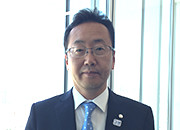
Daiwa Energy
Executive Officer
General Manager, Electric Power Division,
Tomoya Shimakawa
Voices of the Persons in Charge
I was previously in charge of solar power projects, and this is my first experience with wind power. Solar power is perceived as a collection of electronic components, while wind power feels more akin to automobiles. Therefore, knowledge of mechanics, in addition to electricity, is necessary.
Wind power maintenance requires attention and efforts, but it's gratifying when the windmill runs smoothly.

Daiwa Energy
Deputy Manager, Ehime Wind Branch Office,
Susumu Maruo (Left)
Daiwa Energy
Operations Manager,
Sadamisaki Wind Power Station,
Sakae Kimura (Right)



